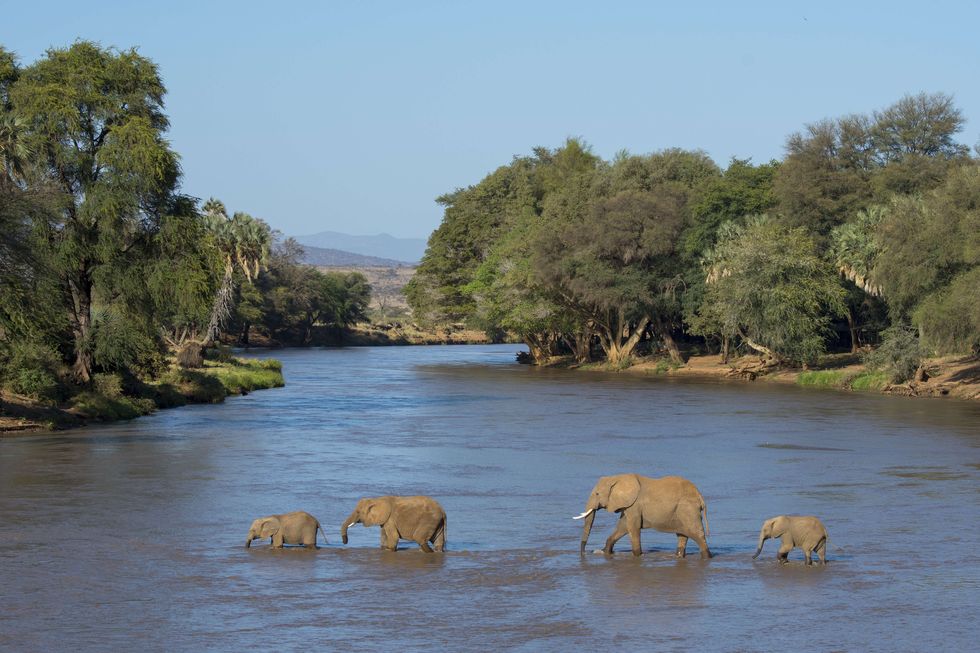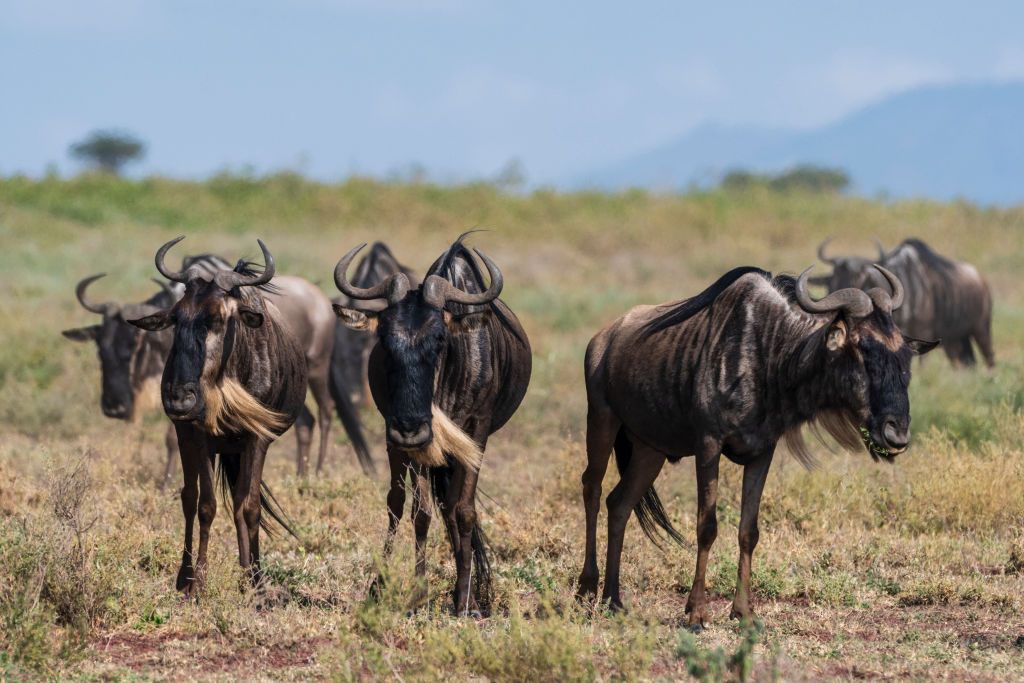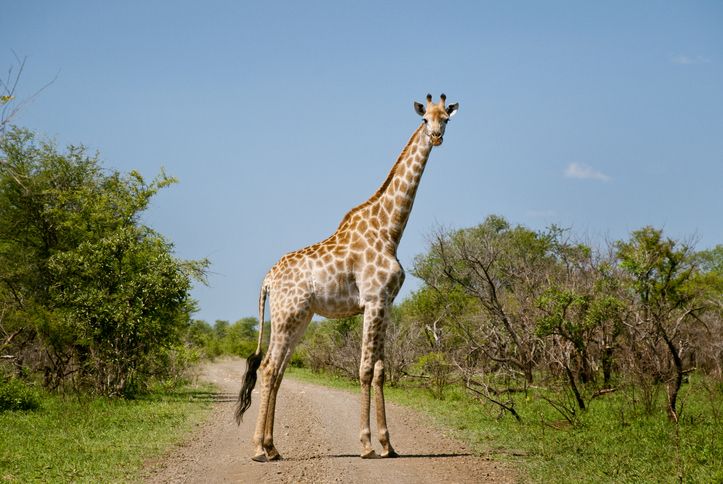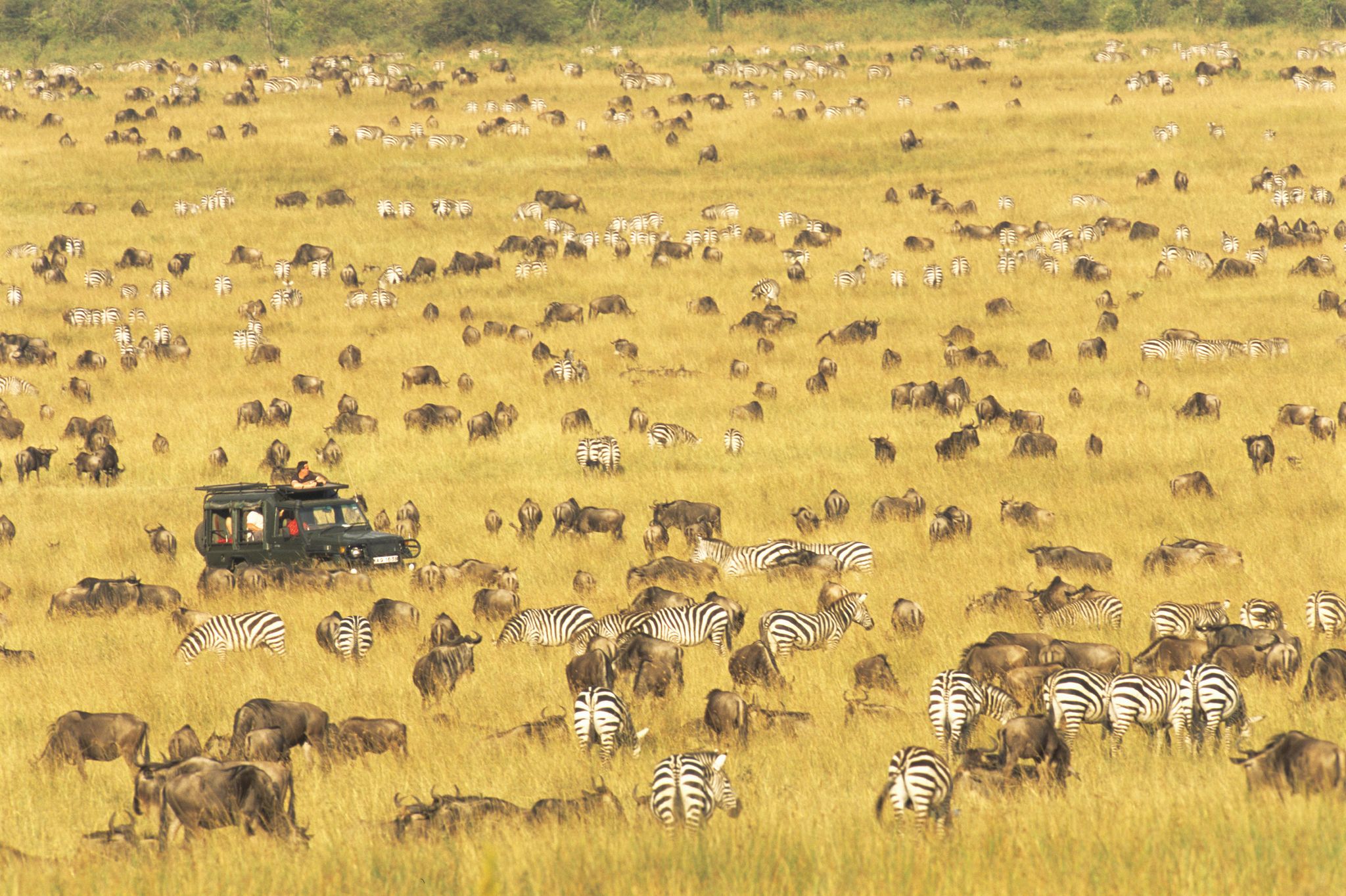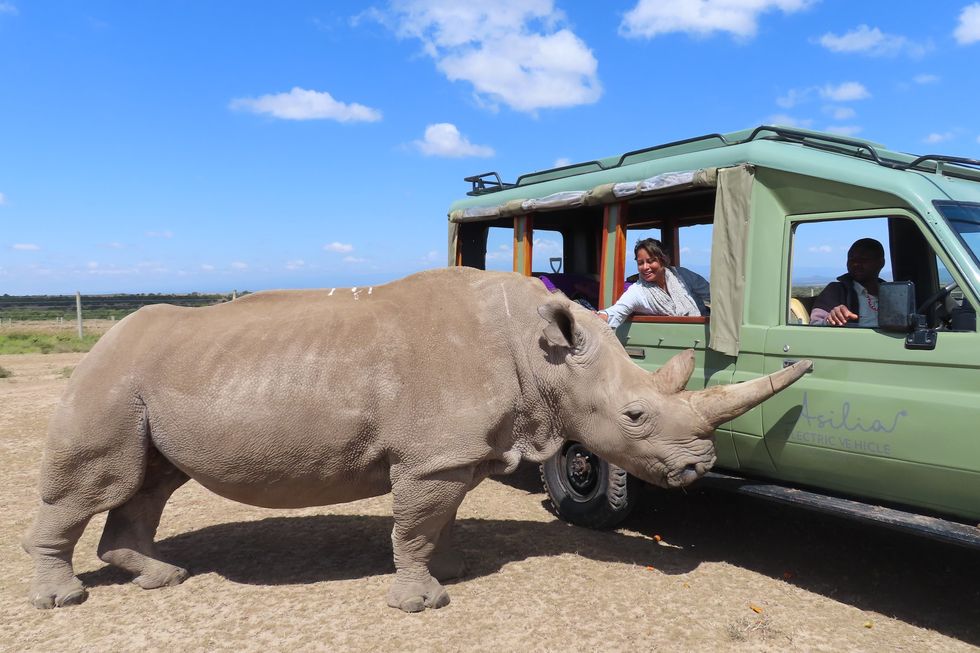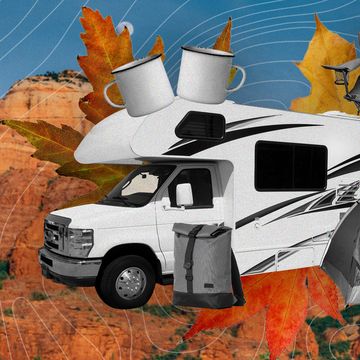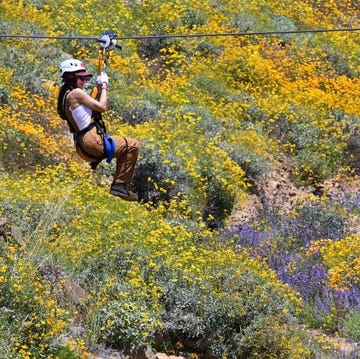In the Shondaland series The Novelty of Nature, we’re digging into the power of natural places and the wellness benefits of embracing the elements. From camping tips and safari stories to eye-opening tales about the environment to inspiring ways to reclaim your relationship with nature, these stories show it’s never been a better time to get lost in the great outdoors.
A rustling outside my canvas tent in a remote part of Kenya’s Ol Pejeta Conservancy jolted me out of my jet-lagged daze. Opening the zipper, I scanned the expansive bush and realized I wasn’t alone. Quietly, I walked toward the barbed wire fence along the edge of an embankment leading to the reddish-brown waters of the narrow Ewaso Ng’iro River. There, knee-deep in the muddy water, stood an adolescent African elephant, 30 or so feet in the distance, completely oblivious to me.
Flapping his giant ears to keep cool, the elephant snaked his nimble trunk around the branches to feast. I let out a gasp; my first instinct was to capture the moment on camera. But I reminded myself to be mindful of this solitude in the wilderness in the presence of such a mighty creature. I stashed my phone away and stood there transfixed, lulled by the cool woodland breeze and warmed by the equatorial sun until the animal moved on. My body relaxed, my worries dissolved, and for a short period, my mind was still enough to be at peace.
Enrapturing experiences like this make a safari thrilling and unforgettable. My introduction to African wildlife came when I was a teenager growing up in a small town in South India. My aunt, who moved to the continent after getting married, mailed photos from a vacation in South Africa. A towering giraffe stood in a grassland near the vehicle, its mahogany patches contrasting against a cloudless, baby-blue sky. The image was etched in my memory.
Ten years later, while living in California after graduating college, I got the chance to go on my own safari. A friend who was on an extended volunteer trip in a rural community along the shores of Tanzania’s Lake Victoria invited me and two other girlfriends to visit. In just a few months, I received the necessary vaccination shots and was on my way with a backpack and nearly empty bank account. The word “safari” translates to “journey” in Swahili; I didn’t realize then that the moment I stepped on African soil would forever change my life.
Two flights to Nairobi and a 12-hour overnight bumpy bus ride to Mwanza later, the four of us arrived exhausted but excited for the adventure ahead. We hired a safari guide and vehicle for a multiday girls’ trip. Our first stop was the Serengeti, the famed national park famous for the greatest spectacle on Earth — the wildebeest migration — where millions of ungulates make the grueling journey across the plains and rivers in the dry season in search of food.
We drove for hours, with the same barren plains passing us by, our hair, faces, and arms covered in dust from the open windows. The scenery changed as we approached the migration. The grayish-brown bodies of the wildebeests, with their black manes stirring, moved like an undulating wave across the endless plains.
While they trudged along, we scanned the savanna for wild cat action, as the migration was prime hunting season. Finally, we spotted a leopard, camouflaged in the tall grass and acacia trees, stalking its prey. My heart rate quickened; I remember standing on the seat and poking my head out of the pop-top roof for a better view. The scene in front of me seemed straight out of a Discovery Channel nature show, and I expected music signifying an impending kill to come on any minute. Alas, there was no dramatic soundtrack, and the leopard slinked off into the grasses with nary any action.
That night, no matter how much I prepared mentally, I wasn’t ready for camping out in the middle of the wilderness. At a campground called Simba Camp on the rim of Ngorongoro Crater in northern Tanzania, the four of us pitched our tent under an imposing tree. The area is part of the Ngorongoro Conservation Area and has the distinction of being the largest unbroken caldera in the world.
After a dinner prepared over a campfire, we piled into our small tent and slipped into our sleeping bags, with just a thin material shielding us from the dangerous bush. Throwing on all the warm clothes we brought, we huddled, fighting the chill that descended soon after the sunset. But the cold wasn’t the only thing that kept us up that night. The shrieks and squeals of hyenas right outside the tent haunted us, ensuring none of us got a wink of sleep. We learned the next morning that it isn’t uncommon for lions and elephants to venture into the camp. After all, we were in their world, cocooned in relative safety, as there was plenty of meaty prey around for predators to stay away from humans.
We headed down the slope of the Ngorongoro Crater. With encircling walls higher than the Empire State Building, the crater is blessed with dense evergreen montane forests, open moors, and grasslands. This Eden is home to the Big Five — elephants, lions, leopards, buffaloes, black rhinos — and other animals, all coexisting in a 102-square-mile area. With barely any other vehicles around, we took our time to stop and spot wildlife, and drove toward the seemingly alien-planet landscape of Lake Magadi, a saline soda lake that attracts hundreds of flamingos who inhabit the shallow saline soda lake. The highlight of the game drive, though, was seeing the endangered black rhino, an animal who eluded us in the Serengeti, where poaching decimated their population.
As we drove up, the setting sun cast a warm glow on the canopy, and brilliant golden rays went in different directions. Underneath, two mating elephants, with their trunks intertwined, playfully wrestled. On this hopeful and adventurous journey, a seed was planted. I became enamored with wildlife, and a desire to protect them took root. This led to a career in writing with a focus on conservation, in which I hoped to inspire others to have similar adventures and protect nature.
Covid put an abrupt end to my traveling days, confining me at home like the majority of the population. The turmoil was made worse by a traumatic event in my family. I was barely hanging onto hope; normalcy seemed like a distant memory, and getting on a plane was a scary proposition.
It was during this long, reflective time that it occurred to me that the most joyful times are when I am living in the moment in pristine wild places. Untouched areas that take me back to another era, where ancient trees like baobabs stand proud, where virgin rainforests, acacia woodlands, and savanna grasses remain havens for wild animals who roam freely as they have for thousands of years. Nowhere on the planet is this more evident than in the protected places in several African countries.
I was dismayed to learn that the pandemic deeply affected communities and halted many conservation efforts. With both tourism income and boots on the ground gone, poaching increased in certain hot spots. It was then I found a new purpose of not merely fulfilling my desire to be immersed in nature but to also do what I could to help. As soon as I was vaccinated, I boarded a flight back to Nairobi, almost 20 years after that fateful journey.
This time, I didn’t sleep on the ground or drive for endless hours. On my first stop in Kenya’s Mara Naboisho Conservancy in the Masai Mara reserve, a community-owned protected land home to abundant wildlife, I upgraded to a tent with canvas walls, a plush bed, and a bathroom with hot showers. I dined on gourmet food overlooking the savanna. I went on twice-daily game drives in an open-air vehicle, snapped photos of the sunrise, and learned about animal tracking on a walking safari. Most rewardingly, I met with the women at a local organization helping uplift women through beadwork.
I continued on to two different camps in the Serengeti, one that is run entirely by women and another in a recently opened conservation area called Namiri Plains, where efforts have resulted in an increase in the cheetah population. On each of my outings at these camps, I brought a notepad and camera in my day bag, a heart full of fresh hope, and a bubbling hankering to share my experiences with others once again.
My outings opened my eyes to the fact that a safari is more than just the Big Five or the African Great Migration. And no game drive is ever the same. One day, it was lions and their cubs feasting on a zebra as jackals and vultures waited their turns, young hyena pups playing near a den, and hundreds of gazelles and impalas grazing and jumping.
On another day, an elephant in musth blocked the way, two cheetah brothers wandered along a drying river in pursuit of their next meal, adorable vervet monkeys groomed each other along the sides of the road, and a male lion roared so close to the vehicle that I felt it in my bones. Birds including ostriches, marabou storks, kori bustards that look like descendants of dinosaurs, and stunning beauties like African fish eagles and lilac-breasted rollers filled up my memory card.
I returned to the continent a few more times to experience its diverse regions, hiking the rain-forested slopes of the Virunga Mountains in Rwanda’s Volcanoes National Park to come face-to-face with endangered mountain gorillas and learn about conservation successes; witnessing anti-poaching guide dogs in training in Akagera National Park; and venturing on solar-powered boat rides to catch sightings of Nile crocodiles, hippos, and herds of elephants along the Chobe River in Botswana with a female guide to report on equity, sustainability, and conservation.
Back at Ol Pejeta Conservancy the day after my elephant encounter, I knew exactly who I was going to see, as I was scheduled to meet Najin and Fatu, the last two remaining northern white rhinos in the world. The two females, who belong to a subspecies of the white rhinoceros, live in a large enclosure with a southern white rhino, under 24-7 armed protection against poachers. Their predecessors roamed the savanna grasslands and woodlands of East and Central Africa. The species is extinct in the wild.
Enticed with a snack, mom Najin walked toward me like an armored vehicle and stuck her horn the size of my forearm into the window. With her massive stature, compared to the four-wheeler I was sitting in, she stood mere inches from me. With my heart pounding and overflowing with joy, I handed her a carrot that quickly disappeared into her square-lipped snout. My shaky hand reached and touched the folds of her thick, rough skin, compelled to memorialize our interaction, as I may never see her species again.
Losing interest once the treats stopped coming, Najin moseyed on and brought herself down onto the ground, laying her massive head on one side as if contemplating life. While Najin doesn’t realize the fate of her species, the gravity of what I just experienced hit me hard. Once these two are gone, the world will forever lose this subspecies, never to be seen again. Our relationship with nature is mutual; it helps us heal, feel joy, and find meaning, and in return, it needs us to protect, preserve, and care for it. It gives us unforgettable moments and makes us appreciate the fragility and beauty of life.
Lavanya Sunkara is a New York-based travel writer who has contributed to Travel + Leisure, National Geographic, Fodor’s, and Readers’ Digest. Follow her on Instagram @nature__traveler.
Get Shondaland directly in your inbox: SUBSCRIBE TODAY

